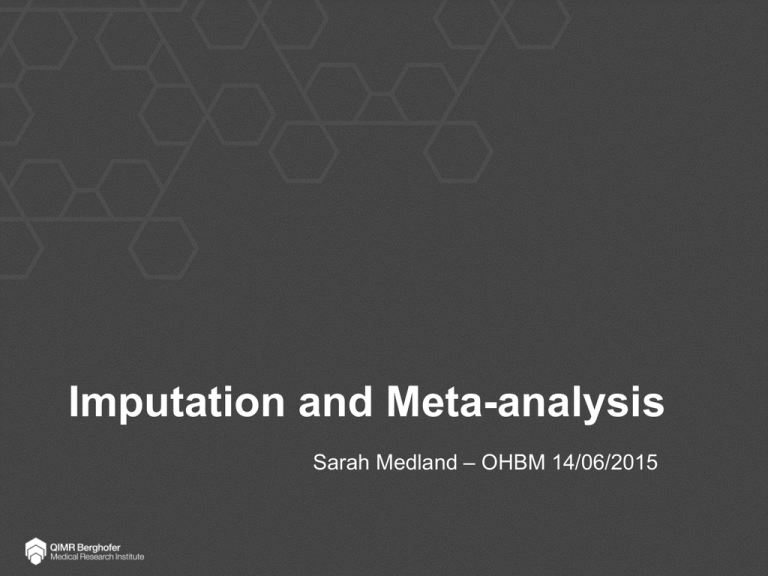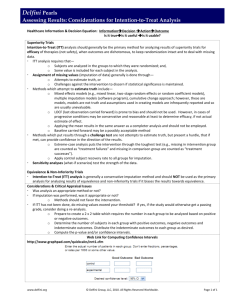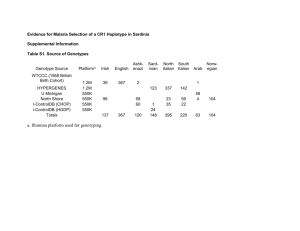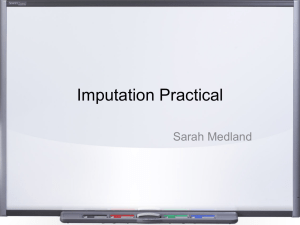Imputation and Meta-analysis Sarah Medland – OHBM 14/06/2015
advertisement

Imputation and Meta-analysis Sarah Medland – OHBM 14/06/2015 Imputation } Why do we impute } } } } To allow comparison with other samples on other chips To fine map – ie run association at variants we have not genotyped To improve call rate – ie increase the number of variants available for poorly genotyped samples (not ideal) To identify genotyping errors A quick conceptual theory of imputation } Start with some genotype data using LD the structure within your data phase your data to reconstruct the haplotypes } A quick conceptual theory of imputation Compare your phased data to the references } Use the LD structure to Impute in the missing genotypes } (Marchini, J. and Howie, B. 2010. Nat Rev Genet 11 499-511.) Easiest (and best) way of imputing } Use the Imputation Servers } } https://imputationserver.sph.umich.edu/ https://imputation.sanger.ac.uk/ But I’m going to assume you have the time, computational capacity, storage space and desire to do this yourself… Step 1 – Pick your references } HapMapII or HapMapIII } } } } 2.4M and 1.3M variants respectively Well imputed and well known set Good for first imputation run – not commonly used anymore 1KGP aka 1000GP } Phase1v3 ~37M variants of these ~11M will be useable } } Phase3v5 ~82M variants of these ~12M will be useable } } 1,092 individuals 2,504 individuals Haplotype reference consortium } } Only from the Imputation servers 39M variants 32,488 individuals of these ? useable… Pick your references } All Ethnicities vs Specific Ethnicity panels } } } } } Consider what the consortiums/collaborators you want to work with want to do Case by case basis All ethnicities panels are larger (and slower) Can be more accurate – esp for a ‘cosmopolitan US’ sample May not improve imputation for homogeneous populations or those with strong founder effects Step 2- Genotype data } Ideally use a chip designed for imputation } } } All chips have data sheets if you are obtaining genotyping make sure you check the sheet before choosing the chip! Also look for papers on imputation using your preferred chip and ask authors who have published using that chip Check the manifests and make sure your favourite genes are covered! Genotype Data } Make sure your data are clean! } } Convert to PLINK binary format Exclude snps with: } } } } } excessive missingness (>5%) low MAF (<1%) HWE violations (~P<10-4) Mendelian errors Exclude variants that are not in your reference panel (optional but recommended) Genotype Data } Make sure your data are clean! Drop strand ambiguous snps (AT and CG snps) } ¨ } Remember: DNA is composed of 2 antiparallel strands the complement of an A is a T and the complement of a C is G this makes it difficult to work out if the genotypes are strand aligned to the references. +ve and –ve strand is an arbitrary construct changes between builds and sources. Much better to drop these SNPs and reimpute them… Align the strand of the non-ambiguous snps rs915677-T rs915677-R rs9617528-T rs9617528-R A 0 .08 .72 0 C .91 0 0 .17 G 0 .92 .28 0 T .09 0 0 .83 Genotype Data } Make sure your map (base pair positions) are on the correct build! } } HapMap references were on hg18 1KGP references are on hg19! } Distance and order of variants can change – absolutely critical that your data and the reference are on the same build!!! Step 3 - Phase your data } Phasing programs “use a hidden Markov model (HMM) to model the haplotypes underlying G as an imperfect mosaic of haplotypes in the set H. Compatible haplotypes are sampled for G using the forward-backward algorithm for HMMs” } Problem: complexity is quadratic and scales with sample size and Nsnps O(MK2) Delaneau, O. et al. 2013. Nat Meth 10 5-6. Phase your data } Currently best program for phasing is SHAPEIT2 } } Avoids the quadratic bottle neck by: } } } Delaneau, O., Zagury, J.-F. et al. 2013. Nat Meth 10 5-6. “collapsing all K haplotypes in H into a graph structure, Hg, and then carrying out the HMM calculations on this graph.” Sampling pairs of haplotypes Transition accuracy is improved by drawing on surrogate family members Phase your data SHAPEIT2 } Transition accuracy is improved by drawing on surrogate family members } } } } restricts each phasing update to a set of k template haplotypes chosen separately for each individual at each iteration The k templates are chosen by computing Hamming distances between an individual's current sampled haplotypes and each possible template haplotype. the k templates with the smallest distances are refereed to as “surrogate family members” SHAPEIT2 } https://mathgen.stats.ox.ac.uk/genetics_software/shapeit/ shapeit.html } Can multi-thread } Note: this is a genetic map based on recombination (cM) not a physical map (BP)! Step 4 – Impute your data } Chose a program } } } } Minimac3 IMPUTE2 Beagle Never use PLINK Imputation program popularity Mach/ Minimac Beagle PLINK Similar accuracy, features, time frame } Different output formats & downstream analysis options } My recommendation } MiniMac3 } } } } } } lower memory and more computationally efficient implementation References are in a custom format (m3vcf) that can handle very large references with lower memory Can read in the SHAPEIT2 references Output is vcf format Includes both SNP and individuals IDs – safest format to avoid errors Downstream analysis with RAREMETALWORKER or other vcf input tools vcf format Imputing in minimac3 } } Can impute X } } Impute Males & Females together for the pseudo Autosomal region (PAR) Separately for the non-PAR Output } } } Comments, info and genotypes in the 1 file 1 line per variant 1 column per person Output } The comments } The info } The genotypes Analyses… } DO NOT ANALYSE HARDCALL GENOTYPES!!!!!! } Analyse the dosage or probabilities as this will account for the imputation uncertainty Analyses in RAREMETALWORKER } Simple phenotype file formats Can account for relatedness & twins } Can use GRM to account for relatedness (memory+++) } Ped file (no header) } } } } Dat file raremetalworker --ped your.ped --dat your.dat --vcf your.vcf.gz prefix example raremetalworker --ped your.ped --dat your.dat --vcf your.vcf.gz kinPedigree --prefix example --- Files to practice with http://genome.sph.umich.edu/wiki/Minimac3_Imputation_Cookbook } But really and truly consider using the Imputation Servers so that you can access the HRC references! } https://imputationserver.sph.umich.edu/ A practical example } } } http://labs.med.miami.edu/myers/LFuN/LFuN.html post-mortem gene expression in ‘brain’ tissue N=193 Imputation Chromosome 22 only – HapMapII- b36r22 } MaCH phasing } } (In real life with a sample this size include the reference in the phasing) } Minimac Imputation } Run twice } } Once without stand alignment Once with strand alignment (badImp) (goodImp) How do we know there was no strand alignment from the output? } No } } way of telling from the phasing log B/c we didn’t include a reference Imputation log is FULL of errors rs915677-T rs915677-R rs9617528-T rs9617528-R A 0 .08 .72 0 C .91 0 0 .17 G 0 .92 .28 0 T .09 0 0 .83 Plot the r2 for the 2 imputation runs } How do they compare? } badImp 17,908/39905 with r2 >=.6 } goodImp 24,685/39905 with r2 >=.6 } still quite bad b/c of small N } Should have compensated by including ref data in the phasing step } In a QIMR dataset N=19k 32296/33815 Bad Imputation Better Imputation Good Imputation Meta-analysis Setting up a Meta-analysis } } Managing the personal and social connections is extremely important meta-analyses are usually unfunded } } Time line is too short and budget is too small for a grant Meta-analyses do not work top down – to be successful they MUST be led by analysts who know what they are doing Evangelou, E. 2013. Nat Rev Genet 14 379-389. Approaches to GWAS meta-analysis } Fixed effects } Most common - most powerful approach for discovery under the model that the true effect of each risk allele is the same in each data set } } } Random effects } } Inverse variance weighted most common N weighted also common Uncommon - more appropriate when the aim is to consider the generalizability of the observed association and estimate the average effect size of the associated variant and its uncertainty across different populations Bayesian } Very uncommon – mainly MAs from the Welcome Trust Quality control of data going into MA is critical! } Exclude rare variants } } Typically 1% or .5% MAF with large samples (5000+) can consider going lower Exclude poorly imputed variants } Imputation accuracy metric depends on the software used } } } } } } Mach/minimac r2 IMPUTE properinfo/info BEAGLE ovarimp Typically calculated as observed variance/expected – can empirically go over 1 usually capped at 1 Threshold .6 Plot } QQ, Manhattan, SE vs N, SE vs MAF, SE vs Rsq, P vs Z GWAS-MA } Most commonly used software for common variant analysis – METAL } } } } } } Automatic strand flipping of non-ambiguous SNPs Calculation of max min mean allele frequency Inverse variance & N weightings Automatic genomic control correction Herogeniety tests Most commonly used software for rare variant analysis RAREMETAL METAL http://www.sph.umich.edu/csg/abecasis/metal/ Documentation can be found at the metal wiki: http://genome.sph.umich.edu/wiki/Metal_Documentation METAL } } Requires results files ‘Script’ file } } } Describes the input files Defines meta-analysis strategy Names output file Steps 1. Check format of results files 1. 2. 2. Prepare script file 1. 2. 3. Ensure all necessary columns are available Modify files to include all information Ensure headers match description Crosscheck each results file matches Process name Run metal INPUT FILES } Results1.txt } Results2.txt Columns METAL uses } } } } } } SNP Effect allele & non-effect allele Frequency of effect allele OR/Beta SE [for standard error meta-analysis] P-value [for Z-score meta-analysis] } } IMPORTANT – you can not use FDR controlled or adaptively permuted P values! N/weight column [for Z-score meta-analysis] Effect allele } Differs for different programs and analysis options } } } } Minor/major allele Alphabetical 1st listed DO NOT ASSUME YOU KNOW ALWAYS DOUBLE CHECK! Genomic control } } } λ (lambda) Median test statistic/ expected median test stat Should be one Strand Ambiguous SNPs When you get data from different studies is not always aligned the same way } Remember A<>T & C<>G } If a SNP is A/C or then the reverse strand is T/G } } } } No ambiguity, regardless of strand we know which allele is which A/G, T/C & T/G also non ambiguous METAL can align you non ambiguous SNPs Strand Ambiguous SNPs } } Remember A<>T & C<>G If a SNP is A/T then the reverse strand is T/A } } } AMBIGUOUS!!! Need to check allele freq to make sure samples are aligned C/G SNPs are also ambiguous! METAL can not align ambiguous SNPs Meta-analysis running We will run meta-analysis based on effect size and on test statistic } For the weights of test statistic, I’ve assumed that the sample sizes are the same } } METAL defaults to weight of 1 when no weight column is supplied Step 2: script file: meta_run_file # PERFORM META-­‐ANALYSIS based on effect size and on test statistic # Loading in the input Ailes with results from the participating samples # Note: Order of samples is …[sample size, alphabetic order,..] # Phenotype is .. # MB March 2013 MARKER SNP ALLELE A1 A2 PVALUE P EFFECT log(OR) STDERR SE speciAies column names PROCESS results1.txt PROCESS results2.txt processes two results Ailes OUTFILE meta_res_Z .txt Output Aile naming ANALYZE Conducts Z-­‐based meta-­‐analysis from test statistic CLEAR Clears workspace SCHEME STDERR Changes meta-­‐analysis scheme to beta + SE PROCESS results1.txt PROCESS results2.txt processes two results Ailes OUTFILE meta_res_SE .txt Output Aile naming ANALYZE Conducts effect size meta-­‐analysis Larger Consortia # PERFORM META-ANALYSIS on P-values module load metal metal << EOT # Loading in the inputfiles with results from the participating samples # Note: Order of samples is alpahabetic # Phenotype is WB # 1. AGES_HAP MARKER SNPID ALLELE coded_all noncoded_all EFFECT Beta PVALUE Pval WEIGHT n_total GENOMICCONTROL ON COLUMNCOUNTING LENIENT PROCESS AGES_HAP.txt # 2. ALSPAC_HAP MARKER SNPID ALLELE coded_all noncoded_all EFFECT Beta PVALUE Pval WEIGHT n_total GENOMICCONTROL ON COLUMNCOUNTING LENIENT PROCESS ALSPAC_HAP.txt AND SO ON (in this case 40 files) Running metal } metal < metal_run_file > metal_run.log metal is the command } metal_run_file is the script file } This will output information on the running of METAL things to standard out [the terminal] } It will spawn 4 files: } } } 2 results files: meta_res_Z1.txt + meta_res_SE1.txt 2 info files: meta_res_Z1.txt.info + meta_res_SE1.txt.info Output you’ll see } } } Overview of METAL commands Any errors And your best hit from meta-analysis Common Errors Output Important considerations for MA } } } Duplicate QC sites Always check the input data Make sure you double check results } } } } QQ plots Manhattan plots Allele frequencies etc Consider allowing cohorts to ignore variants with MAF <. 5% and low r2 – it will save you a lot of time and save a lot of storage space! Don’t ask for stuff you don’t need (Its annoying & adding extra columns*30M lines is a waste of space…) } You need: } } SNP, CHR:BP, EffectAllele, NonEffectAllele, EA_Freq, Ntotal, Beta, SE, P, Rsq Not Questions?






